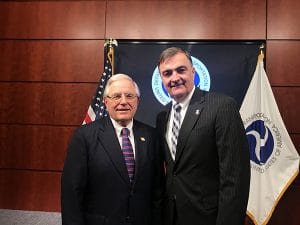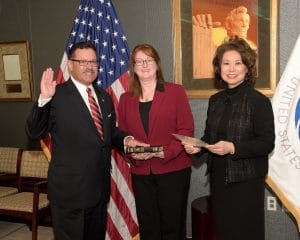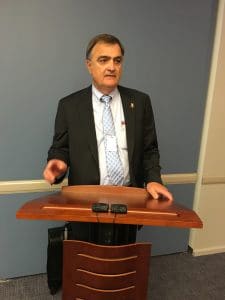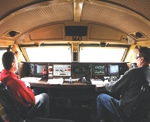The Trump administration’s Federal Railroad Administration (FRA) has declined a request made by SMART Transportation Division to address the safety concerns of excessively long trains.
In an April 25, 2017, letter from National Legislative Director John Risch to Robert Lauby, FRA’s associate administrator for safety, Risch referenced a pair of trains – one CSX train consisting of 234 cars and exceeding 2 ½ miles in length and a BNSF train that had 246 cars that also exceeded 2 ½ miles.
Risch said in the letter that such “incredibly long” trains pose challenges to crew radio communications and maintaining brake pipe pressure, block more rail crossings and that crews are not adequately trained to handle these dangerously long trains.
But those concerns were simply brushed aside by Lauby.
“FRA does not have sufficient data or evidence to justify an Emergency Order limiting the length of trains,” he wrote in his March 7, 2018, response, saying also that the carriers were lengthening trains in an attempt “to enhance service delivery and operational efficiencies.”
Here is the link to Risch’s original letter and the pro-industry response received nearly a year later.
“The letter signed by Lauby looked like it was written by some railroad lobbyist,” Risch said. “Anyone who has ever dealt with a 2-mile-plus-long train knows they are anything but efficient. They tie up the railroad because sidings and rail yards can’t handle them.”
Risch testified last October in a Surface Transportation Board listening session centered on CSX’s service problems about the numerous dangers posed by longer trains.
This testimony plus derailments and other safety concerns, such as blocked crossings, did cause members of the House Transportation Committee to take notice.
A letter from U.S. Reps. Peter DeFazio and Michael Capuano, Democratic members of the committee, spurred the Government Accountability Office (GAO) to begin an investigation last month into the effects of excessively long trains and the safety hazards that they pose.
That investigation is ongoing.
Tag: Federal Railroad Administration

The testing rates will continue to be 25 percent of covered service employees for drug testing and 10 percent of covered service employees for alcohol testing.
As per a recent final rule, maintenance-of-way (MOW) employees will become subject to the FRA random drug and alcohol testing beginning June 12, 2017. Since the FRA does not yet have data on MOW employees, testing rates for MOW will be set at 50 percent for random drug testing and 25 percent for random alcohol testing for the period starting June 12, 2017, through Dec. 31, 2017.
Click here to read the official notice from the FRA as published in the Federal Register.
Provides new path for passenger safety to be evaluated and achieved; Agency invites comments on proposal
WASHINGTON – The Federal Railroad Administration (FRA) proposed updates for the passenger train safety standards used in the United States as the country looks to add high-speed trains that can travel up to 220 miles per hour and replace its aging passenger fleet. The proposed updates represent nearly a decade of work by FRA’s passenger rail division.
“As several regions of the United States build faster passenger rail service, the trains on those tracks must keep passengers safe,” said U.S. Transportation Secretary Anthony Foxx. “To do that, we want to allow manufacturers to innovate and achieve all-new levels of safety. These proposed changes put us on track to do just that.”
The proposed updates would establish a new category of passenger equipment, Tier III, for trains traveling up to 220 mph. The updates would offer an alternative method for evaluating how well passengers and crews are protected in an accident, often called crashworthiness. The public, railroad industry, railroad labor, manufacturers and other stakeholders will have an opportunity to provide feedback and comment on the proposed rule during the next 60 days.
In addition to measuring a train’s crashworthiness based on whether it meets current prescriptive strength standards, the proposed changes would allow a train’s crashworthiness to be evaluated based on it meeting an equivalent level of safety achieved through crash energy management technology or other innovative engineering methods.
“We look forward to hearing from everyone on how this proposal can help our country build a stronger passenger rail network – one that is not only faster but allows for new technologies to make passenger trains even safer,” said FRA Administrator Sarah E. Feinberg.
Although Tier III trains will be required to have exclusive track to operate at speeds above 125 mph, the new standards will allow Tier III trains to safely share track with current Tier I and Tier II commuter, intercity and Acela trains. Compatibility between equipment types is a key strategy to allow trains to share existing corridors to reach downtown stations.
Click here to view the proposed updates.
Proposed rule: “Competitive Passenger Rail Service Pilot Program”

SMART TD, TTD and all of rail labor opposed this concept and other privatization mandates as the bill was going through the legislative process and fought to remove it or include conditions that would protect workers and create a level playing field if it ever went into effect. In the end, while the pilot provision stayed in the final bill, a number of conditions were attached to it at our request and it was limited to three long-distance routes. Given the political realities we face on the Hill and the opposition to Amtrak that exists, this was not an easy task.
TTD submits comments on proposed rule
Yesterday, September 6, the Transportation Trades Department (TTD) of the AFL-CIO commented on the proposed rule published by the FRA. Click here to read TTD’s comments.
National Legislative Director John Risch on TTD’s comments:
“The comments filed by TTD urge FRA to ensure that labor, service and Buy America rules that attach to this program are fully implemented. Specifically, TTD’s comments call on FRA to ensure that so-called 4R rail employee protections cover workers impacted by this program. As TTD notes in their comments, we think the law requires this result, but we need to make sure the FRA implements this in the right way. I should note that Rich Edelman, on behalf of the BMWE (which was not included in TTD’s comments since they are not members) also filed comments. Edelman, who has a strong background in this area of the law, goes into more detail on the legal background on the protections which should be helpful. It is important to note that both TTD and Edelman’s comments are on the same page. (Click here to read Edelman’s comments.) They demand 4R act protections and our comments have a whole section that talks about why they are legally needed to be applied and specifically ask that the proposed regulations be amended to require any winning bidder be responsible for those protections. We also are asking FRA to issue guidance to adopt them to this situation.
“TTD’s comments also urge FRA to adopt hiring preferences and procedures for Amtrak employees and to ensure that any new entity is covered by rail laws just like Amtrak is today.
“We all need to keep this in perspective. Amtrak receives preferential pricing from the Class 1’s to operate over their track, something the Class 1’s have for years decried as inadequate. A new entrant will not likely receive nearly as good an operating rate as Amtrak currently does. If there is a winning competitive bidder on any of these three routes they will only receive 90 percent of the funding that Amtrak currently receives to provide the service making the bidding process even harder.”
SMART TD Testifies before FRA
Today, September 7, the FRA held a public hearing on the proposed rule. SMART Transportation Division National Legislative Director John Risch was at the hearing and testified on behalf of SMART TD. Click here to read his comments.
SMART Transportation Division President John Previsich and Brotherhood of Locomotive Engineers and Trainmen (BLET) President Dennis Pierce, issued a joint statement, following their submission of their comments to the Federal Railroad Administration (FRA) on train crew size.
“Operating freight trains with one-person train crews is unsafe and must be prohibited. That is the message we delivered yesterday in the comments filed with federal rail safety regulators,” Previsich and Pierce said.
“Our comments provide a clear rationale for the FRA to finalize a rule this year and to close loopholes included in the agency’s initial proposed rule that could permit the limited use of one-person crew freight operations.”
Click here to read the official press release from both unions.
Click here to read the comments submitted to the FRA, followed by the polling results of 11 individual states on two-person crews conducted by DFM Research on behalf of SMART TD (see page 18 for polling results).
On Wednesday, June 15, SMART Transportation Division and the Brotherhood of Locomotive Engineers and Trainmen (BLET) submitted their joint comments on the Federal Railroad Administration’s (FRA) proposed two-person crew rule.
While both unions strongly support the proposed rule, they suggested in their comments that the rule be made stronger before being made final.
“We firmly believe that the only safe way to operate a train is with a crew of at least two people – a federally certified locomotive engineer and a federally certified conductor,” the unions emphasized.
Click here to read the unions’ comments. Following the comments (on page 18) are the polling results of 11 individual states on two-person crews conducted by DFM Research on behalf of SMART TD.
Members, family, friends and communities can comment on the proposed rule until tonight at 11:59 p.m. eastern time and are encouraged to do so. Click here to comment.

May an employee wear a device like a “Garmin Vivofit” or “Fitbit” wristband that acts like a watch, and counts the steps that an individual takes each day? The devices are not searching for the internet, or Wifi, to do this and must be synchronized with Bluetooth on a separate device. The devices are essentially digital watches and track the number of steps an individual takes each day in the background. Does the FRA consider these devices “smart watches”?
FRA considers Fitbits and similar devices to be “personal electronic devices” that are subject to the restrictions in part 220. Per the definition of an “electronic device” at 49 CFR 220.5, they are an electronic device that performs functions not necessary for the health or safety of that person and entail the risk of distracting employees from safety-related tasks.
FRA understands some Fitbit devices are rather limited in their functionality. However, a number of different fitness tracking devices are available. The Fitbit Blaze, for example, has functions that include mobile playlists, call alerts, text alerts and fitness tracking. These functions are the same type of distracting functions that have caused railroad accidents and were the impetus for the restrictions contained in part 220.
The regulation text of part 220 does not distinguish between Fitbits that have limited functionality, and those that are more akin to smartphones or smartwatches. Unless a waiver granting an exemption for certain fitness tracking devices with limited functionality were issued by FRA in the future, the agency considers all such devices to be “personal electronic devices” that are subject to the restrictions in part 220. However, railroad operating employees are allowed the use of digital clocks or wristwatches whose primary function is to tell time.
Timepieces are commonly used in the railroad industry to verify the accuracy of a locomotive’s speed indicator. This function is safety-related in that it accurately allows a train crew to comply with relevant track speed limits during the course of a train’s movement. This exception is limited to those wristwatches that do not have functions which violate the requirements set forth under 220 subpart C. The Primary function of fitness tracking devices is not to tell time.
As stated in Title 49 CFR 220.303, a railroad operating employee shall not use an electronic device if that use would interfere with the employee’s or another railroad operating employee’s performance of safety-related duties. No individual in the cab of a controlling locomotive shall use an electronic device if that use would interfere with a railroad operating employee’s performance of safety-related duties.
The exceptions within 220 subpart C account for varying operating situations, with particular flexibility for railroad supplied devices.
The only exceptions within 220 subpart C are specially stated in § 220.309:
§ 220.309 Permitted uses; exceptions to other restrictions.
Notwithstanding any other limitations in this subpart, a railroad operating employee may use the following, if that use does not interfere with any employee’s performance of safety-related duties—
(a) The digital storage and display function of an electronic device to refer to a railroad rule, special instruction, timetable, or other directive, if such use is authorized under a railroad operating rule or instruction.
(b) An electronic device as necessary to respond to an emergency situation involving the operation of the railroad or encountered while performing a duty for the railroad.
(c) An electronic device to take a photograph of a safety hazard or a violation of a rail safety law, regulation, order, or standard, provided that—
- A camera that is part of a cell phone or other similar multi-functional electronic device is not included in this exception unless it is a railroad supplied device and is used for an authorized business purpose;
- The camera, unless otherwise permitted, is turned off immediately after the documentation has been made; and
- If the camera is used in the cab of a moving train, the use is only by a crewmember other than the locomotive engineer.
(d) A stand-alone calculator if used for an authorized business purpose.
(e) A medical device that is consistent with the railroad’s standards for medical fitness for duty.
(f) A wireless communication device to conduct train or switching operations if the railroad operating employee is part of a crew assigned to a train that is exempt under § 220.9(b) from the requirement of a working radio when the employing railroad has fewer than 400,000 annual employee work hours.
Additionally, railroads may impose more stringent requirements that are subject to change at the railroad’s discretion, without notice to FRA, and can vary from railroad to railroad.











